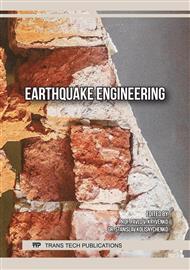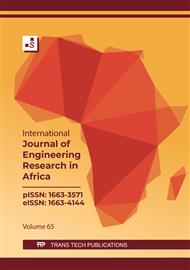[1]
C. C. Hung and P. L. Hsieh, Comparative study on shear failure behavior of squat high-strength steel reinforced concrete shear walls with various high-strength concrete materials, Structures, 23 (2020) 56–68.
DOI: 10.1016/j.istruc.2019.11.002
Google Scholar
[2]
A. Tuken and N. A. Siddiqui, Assessment of Shear Wall Quantity in Seismic-Resistant Design of Reinforced Concrete Buildings, Arab. J. Sci. Eng., 38 (2013) 2639–2648.
DOI: 10.1007/s13369-012-0482-0
Google Scholar
[3]
Sumanth Chowdary and S. Pandian, A Comparative Study on RCC Structure with and without Shear Wall, Int. J. Sci. Res. Dev., 2 (2014) 916–919.
Google Scholar
[4]
Dassault Systemes, Abaqus. Retrieve from http://www.3ds.com/products-services/simulia/products/abaqus/. (2017).
Google Scholar
[5]
G. Tunç and M. Al-ageedi, A parametric study of the optimum shear wall area for mid-to high-rise rc buildings, Konya J. Eng. Sci., 8 (2020) 601–617.
Google Scholar
[6]
Y. Rajesh Kumar and P. Bharath Kumar, Effect of shear wall area to floor area ratio on seismic performance of R.C. structures, Int. J. Civ. Eng. Technol., 9 (2018) 844–852.
Google Scholar
[7]
L. Miao, L. Jin, D. Li, X. Du, and B. Zhang, Effect of shear-span ratio and vertical reinforcement ratio on the failure of geometrical-similar RC shear walls, Eng. Fail. Anal., 139 (2022).
DOI: 10.1016/j.engfailanal.2022.106407
Google Scholar
[8]
B. Burak and H. G. Comlekoglu, Effect of Shear Wall Area to Floor Area Ratio on the Seismic Behavior of Reinforced Concrete Buildings, J. Struct. Eng., 139 (2013) 1928–1937.
DOI: 10.1061/(asce)st.1943-541x.0000785
Google Scholar
[9]
N. Aly and K. Galal, Effect of Ductile Shear Wall Ratio and Cross-Section Configuration on Seismic Behavior of Reinforced Concrete Masonry Shear Wall Buildings, J. Struct. Eng., 146 (2020) 04020020.
DOI: 10.1061/(asce)st.1943-541x.0002542
Google Scholar
[10]
M. A. Cando, M. A. Hube, P. F. Parra, and C. A. Arteta, Effect of stiffness on the seismic performance of code-conforming reinforced concrete shear wall buildings, Eng. Struct., 219 (2020) 110724.
DOI: 10.1016/j.engstruct.2020.110724
Google Scholar
[11]
R. M. Saravanakumar, Optimum Location of Shear Wall in G + 6 Building at the Outer Periphery Using Pushover Analysis, (2022).
DOI: 10.21203/rs.3.rs-2046019/v1
Google Scholar
[12]
R. Banerjee and J. B. Srivastava, Defining Optimum Location of Shear Wall in an Irregular Building by Considering Torsion, Int. J. Eng. Adv. Technol., 9 (2020) 2247–2251.
DOI: 10.35940/ijeat.d6822.049420
Google Scholar
[13]
A. Titiksh and G. Bhatt, Optimum Positioning of Shear Walls for Minimizing the Effects of Lateral Forces in Multistorey-Buildings, Arch. Civ. Eng., 63 (2017) 151–162.
DOI: 10.1515/ace-2017-0010
Google Scholar
[14]
I. Computers and Structures, ETABS - Three Dimensional Analysis of Building Systems. Berkeley, California, (1998).
Google Scholar
[15]
B. Baral and C. Ghimire, Study on the Optimum Location of Shear Wall in Reinforced Concrete Building, Int. Res. J. Eng. Technol., 8 (2021) 2168-2176.
Google Scholar
[16]
R. Patil, A. S. Deshpande, and S. Sambanni, Optimal Location of Shear Wall in High Rise Building Subjected To Seismic Loading, Int. J. Technol. Res. Eng., 3 (2016) 2678–2682.
Google Scholar
[17]
M. R. Suresh, The Optimum Location of Shear Wall in High Rise R.C Bulidings Under Lateral Loading, Int. J. Res. Eng. Technol., 4 (2015) 184–190.
DOI: 10.15623/ijret.2015.0406031
Google Scholar
[18]
O. Soydaş, Evaluation of Shear Wall Indexes for Reinforced Concrete, (2009).
Google Scholar
[19]
TEC, Turkish earthquake code, ministry of public works & settlement, 161 (2007).
Google Scholar
[20]
RPA99V2003, DTR BC 2-48 Règles Parasismiques Algériennes RPA 99 / version 2003, Cent. Natl. Rech. appliquée en Génie paraSismique, (2003).
Google Scholar
[21]
FEMA 440, Improvement of Nonlinear Static Seismic Analysis Procedures, vol. 440, (2005).
Google Scholar
[22]
J. H. Thomsen and J. W. Wallace, Displacement-Based Design of Slender Reinforced Concrete Structural Walls—Experimental Verification, J. Struct. Eng., 130 (2004) 618–630.
DOI: 10.1061/(asce)0733-9445(2004)130:4(618)
Google Scholar
[23]
J. H. Thomsen IV and J. W. Wallace, Displacement-Based Design of Reinforced Concrete Structural Walls: An Experimental Investigation of Walls with Rectangular and T-Shaped Cross-Sections, Natl. Sci. Found., (1995) 1–375.
Google Scholar
[24]
O. K. Soureshjani and A. Massumi, Seismic behavior of RC moment resisting structures with concrete shear wall under mainshock–aftershock seismic sequences, Bull. Earthq. Eng., 20 (2022) 1087–1114.
DOI: 10.1007/s10518-021-01291-x
Google Scholar
[25]
CEN. EN 1998-3, Eurocode 8-Design of structures for earthquake resistance-Part 3: Assessment and retrofitting of buildings, (1998).
Google Scholar
[26]
ATC-40, Seismic evaluation and retrofit of concrete buildings volume 1 ATC-40, ATC 40, Appl. Technol. Counc., (1996).
Google Scholar
[27]
FEMA 356, American Society of Civil Engineers, FEMA 356 Prestandard and Commentary for the Seismic Rehabilitation of Building, US Fed. Emerg. Manag. Agency, 2000., (2000).
Google Scholar
[28]
M. J.B., P. M.J.N., and P. R, Theoretical Stress-Strain Model for Confined Concrete, J. Struct. Eng., 114 (1984) 1804–1826.
Google Scholar
[29]
H. QI and Y.-G. QI, The Uniaxial Constitutive Models of Reinforcement and Concrete for Nonlinear Dynamic Analysis, Proc. 2014 Int. Conf. Mech. Civ. Eng., 7 (2014) 162–165.
Google Scholar
[30]
LATBDSC, An Alternative Procedure for Seismic Analysis and Design of Tall Buildings Located in the Los Angeles Region, (2008).
Google Scholar
[31]
A. A. Farghaly, Seismic assessment of slender high rise buildings with different shear walls configurations, Adv. Comput. Des., 1 (2016) 221–234.
DOI: 10.12989/acd.2016.1.3.221
Google Scholar



